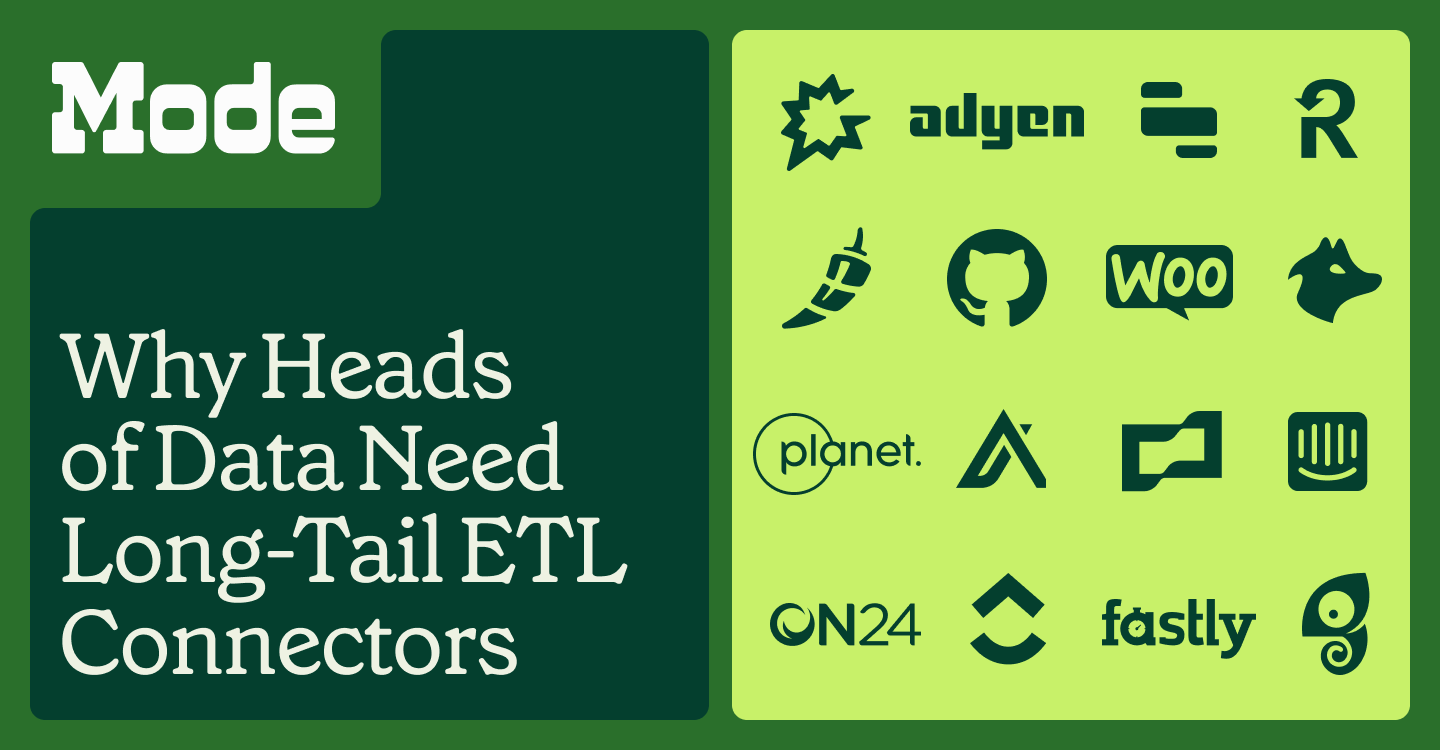Agile Analytics: Why You Should Embrace Incremental Shipments
Mark Simborg, Mode writer
March 13, 2023•Updated on March 13, 2023
NaN minute read

What is Agile Analytics?
Agile analytics is simply the application of agile methodology to analytics.
Per Atlassian:
Agile is an iterative approach to project management and software development that helps teams deliver value to their customers faster and with fewer headaches. Instead of betting everything on a "big bang" launch, an agile team delivers work in small, but consumable, increments. Requirements, plans, and results are evaluated continuously so teams have a natural mechanism for responding to change quickly.
As opposed to the traditional "waterfall" approach, which follows a linear process of moving from one contributor to the next in a series of waterfalls, agile is a collaborative, cross-functional process that relies on trust and open communication. While there is typically a project leader to set goals and timelines, it’s the greater team’s responsibility to determine how the work gets done.
Applying the agile methodology to analytics helps both business and data teams in fundamental ways (discussed below).
Why is agile analytics important?
Data teams need to get data and reports delivered to their business teams fast, and an agile method is always going to be better for that.
Per Benn Stancil, Mode’s co-founder and CTO:
"From all the conversations we've had, one signal has emerged as the clearest indicator of likely success: The analytics team is agile, and they constantly deliver incremental progress."
After observing two different data teams—one, which over-indexed on planning for the long game; the other, which focused on delivering incremental shipments—the more agile team was more effective and delivered more business value in a shorter time period.
Establishing a data-driven culture means investing in data tools, people, and processes. Agile analytics fall squarely into the “process” part of this equation.
What are agile data tools?
For data task prioritization, the most common agile data for prioritization include kanban boards that help you visualize the planning process and sprints. Other frequently used agile data tools include scrums, workflows, and Gantt charts.
Any data tools that support the agile analytics or agile methodology processes could be considered agile data tools. A BI tool is an agile data tool if it has a huge range of flexible and allows for fast, iterative ad hoc analysis.
What makes a BI tool agile?
It’s flexible enough for analysts to move through a workflow without needing to jump into another tool, eliminating a tool-switching tax.
It’s flexible enough to let analysts work with raw and modeled data.
It lets analysts move from a SQL Editor, to Notebooks, to visualizations in a single platform.
It accommodates both business and data team workflows.

Why Today’s Companies Need Collaborative Data Analysis
Business teams and data teams need to work on analytics together—here's how to accomplish that.
Benefits of agile analytics
Agile analytics benefits both the business team and the data team.
For the business team, agile analytics lets them weigh in sooner on iterations from the data team.
As Adam Smith, Analytics Manager at Imperfect Foods, told Mode:
"When I first joined, the data team felt a little like they had to keep the data secure and it was their job to make sure that no one ever looked at a piece of data that was wrong. And that sounds like a perfectly good goal when you state it like that, but the problem is that people don’t get to see in-progress dashboards even though that’s a great opportunity to collaborate and understand how that would really work."
For data teams, agile analytics accelerates innovation and go-to-market time, and lets them focus on what they do best while keeping the business side happy.
How to set up successful agile analytics processes
Agile analytics works best when it’s part of a collaborative process that has a set of basic, shared assumptions around what you are trying to achieve and why.
If you’re a brand new data team, consider these things:
Don't have metrics yet? Think about what today's most critical company challenges are and build metrics that better inform those needs. Work with stakeholders on determining key metrics are most important. We designed a metrics template for this exact purpose.
Metrics Definition Template
Use this template to define metrics with stakeholders.
Not sure which technology to use? Start with a data infrastructure that can provide value quickly and also has low setup costs, then go for your add-ons, but make sure they are add-ons that add real value.
What will work for agile analytics processes are the same things that work for agile methodologies in general:
Incorporate user feedback in each release cycle.
Have a normalized process to complete work and establish it as a workflow. Be sure to make it clearly structured and repeatable, which will make it scalable.
Also, the following will help:
Prioritize decisions over dashboards: Focus on your goals and what you want to achieve with your agile analytics, and don’t get stuck in the weeds. Analysts should be helping companies make better decisions and sometimes that’s at odds with producing tons and tons of dashboards.
Don’t let the perfect be the enemy of the good: Remember the idea is to act quickly and nimbly. Shooting for perfection won’t help with quick iterations. Focus on moving from one question to the next as quickly as possible. In early-stage analytics, decide and move forward.
Remember that sharing is caring: Building trust means sharing all the data you have and not gatekeeping it. Share responsibly, yes, but consider getting reports out to folks for earlier edits instead of waiting until the last minute.
Automate. Being truly agile means automating as many rote and manual processes as possible. Try to automate reports any process that needs to be done more than once. The more you can automate, the more you can focus on developing user features.
Collaborate. This almost goes without saying since collaboration is at the heart of agile methodology. When it comes to the collaboration part, it’s important to remember that everyone shares the responsibility for the project’s success. Daily collaboration is essential, as is setting up a collaborative team workspace.
Why Mode for agile analytics
Being agile is all about being able to quickly adapt to change. Mode is building advanced analytics software that rebuilds analysts’ workflows and combines them with a focused self-serve experience. Mode makes analysts’ jobs easier by bringing the most important technical workflows—extracting data with SQL, analyzing it in Python and R, visualizing results, and sharing a range of analytical assets—in a single, seamless experience.
Mode helps you apply data to every business decision, with an unmatched flexibility that scales with your organization as you grow.
With Mode, you can:
Answer more questions, faster.
Speed up the decision-making process
Iterate quickly through raw or modeled data to answer questions at the speed of today’s businesses.
Get our weekly data newsletter
Work-related distractions for data enthusiasts.




